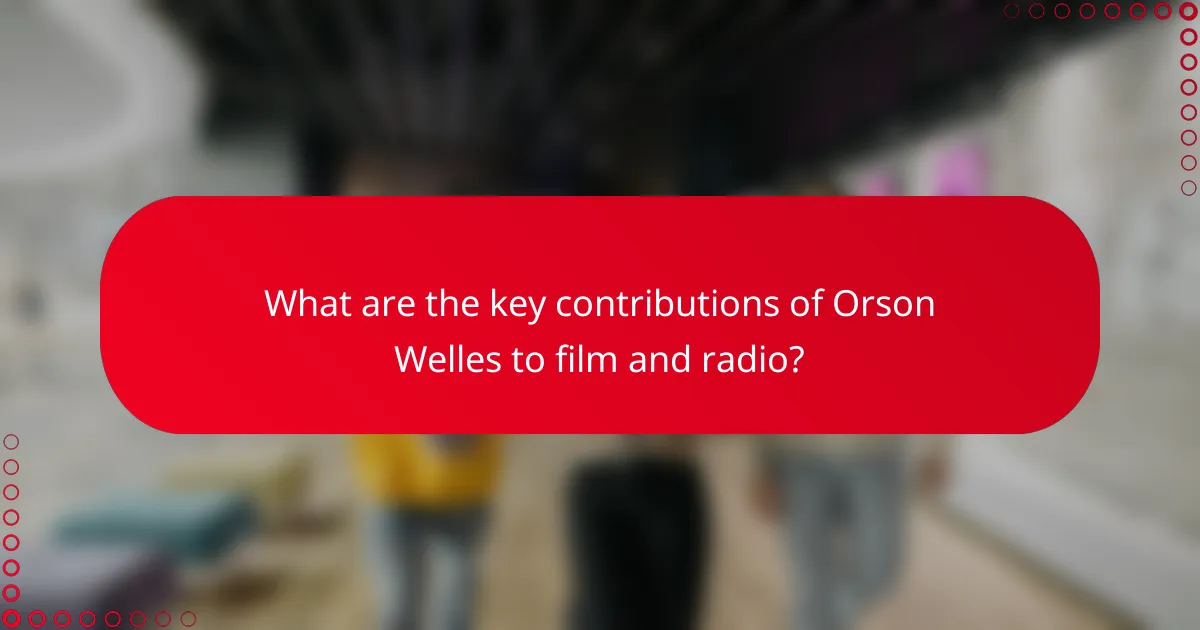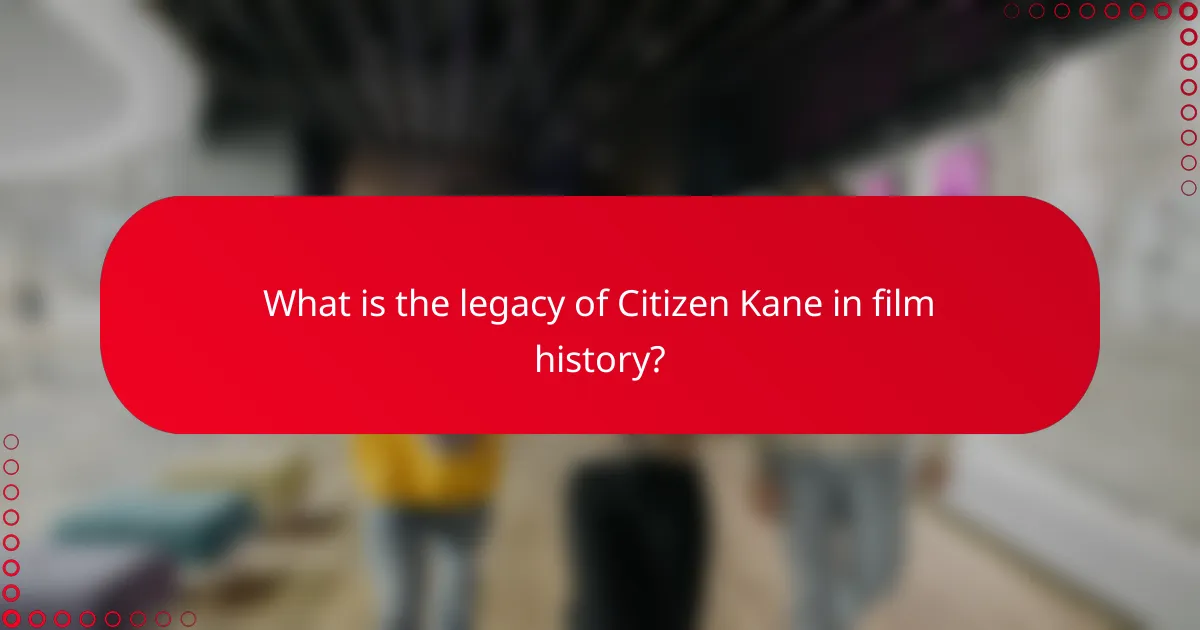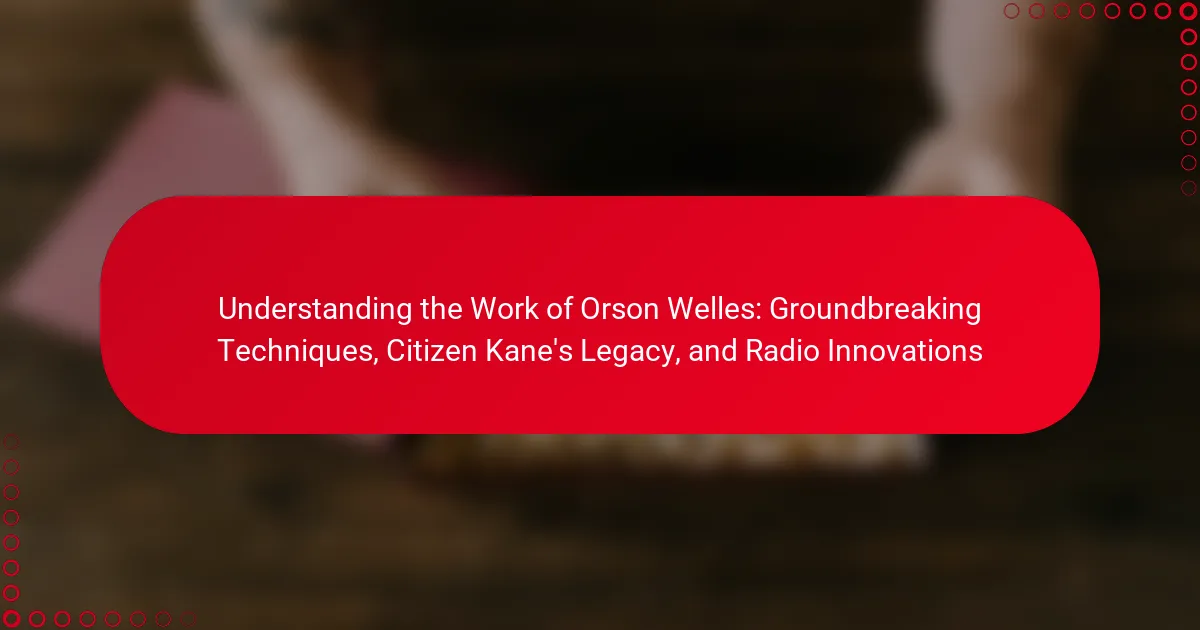Orson Welles is a pivotal figure in film and radio, known for his groundbreaking techniques that transformed both mediums. His film “Citizen Kane,” released in 1941, is celebrated for its innovative narrative structure, deep focus cinematography, and complex character development, earning it a place among the greatest films in history. In radio, Welles gained notoriety for his 1938 broadcast of “The War of the Worlds,” which revolutionized storytelling by blending drama with news formats, creating an immersive experience for listeners. This article will explore Welles’ contributions to cinema and radio, highlighting the lasting impact of “Citizen Kane” and his innovative techniques in both fields.

What are the key contributions of Orson Welles to film and radio?
Orson Welles significantly transformed both film and radio. In film, he is best known for directing and starring in “Citizen Kane.” This 1941 film is often regarded as one of the greatest movies of all time. Welles introduced innovative narrative techniques and deep focus cinematography. His use of non-linear storytelling and complex characters set new standards in filmmaking.
In radio, Welles gained fame for his 1938 broadcast of “The War of the Worlds.” This program famously caused public panic by presenting a realistic depiction of an alien invasion. Welles’ ability to blend drama with news formats revolutionized radio storytelling. His contributions established new artistic standards in both mediums.
How did Orson Welles revolutionize storytelling in cinema?
Orson Welles revolutionized storytelling in cinema through innovative narrative techniques and cinematic style. He introduced non-linear storytelling, as seen in “Citizen Kane.” This film utilized flashbacks and multiple perspectives to enhance the narrative complexity. Welles also employed deep focus cinematography, allowing foreground and background elements to be in sharp focus simultaneously. This technique created a more immersive viewing experience. Additionally, Welles integrated sound and visuals in groundbreaking ways, enhancing emotional depth. His use of voiceover and overlapping dialogue added layers to character development. Welles’ approach influenced future filmmakers, establishing new standards for narrative and visual storytelling in cinema.
What innovative techniques did Welles employ in his films?
Orson Welles employed innovative techniques such as deep focus cinematography and non-linear storytelling. Deep focus allowed multiple planes of action to be in sharp focus simultaneously. This technique was notably used in “Citizen Kane,” enhancing viewer engagement. Non-linear storytelling broke traditional narrative structures, creating a more complex plot. Welles also utilized innovative sound design, blending dialogue with atmospheric sounds to enhance realism. His use of chiaroscuro lighting created dramatic contrasts, influencing visual storytelling in cinema. These techniques have left a lasting impact on filmmaking, showcasing Welles’ creativity and vision.
How did Welles’ background influence his cinematic style?
Orson Welles’ background significantly influenced his cinematic style. He was exposed to theater and literature from a young age. Welles’ early work in radio and stage productions shaped his narrative techniques. His experience with live performances instilled a sense of immediacy in his films. Welles also drew from his knowledge of visual arts, particularly painting. This background led him to experiment with lighting and composition. His upbringing in a creative environment encouraged innovative storytelling methods. Welles’ diverse influences contributed to his unique cinematic voice.
What impact did Orson Welles have on radio broadcasting?
Orson Welles significantly transformed radio broadcasting. He introduced innovative narrative techniques that changed storytelling. His 1938 broadcast of “The War of the Worlds” demonstrated the power of realism. The program caused widespread panic, showcasing the medium’s potential impact. Welles utilized sound effects and dramatic pacing to enhance engagement. This approach influenced future radio dramas and productions. His work set a new standard for audio storytelling. Welles’ innovations remain foundational in the evolution of radio broadcasting.
How did Welles’ radio work shape public perception of media?
Welles’ radio work significantly shaped public perception of media by demonstrating its power to influence and manipulate audiences. His 1938 broadcast of “The War of the Worlds” caused widespread panic among listeners who believed the fictional news reports were real. This event highlighted the potential for radio to create immersive experiences that could blur the lines between reality and fiction. It also raised awareness about the responsibility of media creators in shaping narratives. Following this broadcast, public trust in media became more scrutinized. Audiences began to question the reliability of news sources. Welles’ innovative storytelling techniques further established radio as a serious medium for artistic expression. Overall, his work transformed how the public engaged with and understood media’s impact on society.
What are some notable radio productions by Orson Welles?
Orson Welles is known for several notable radio productions. His most famous work is “The War of the Worlds,” aired in 1938. This broadcast caused widespread panic by portraying a Martian invasion as a real news event. Another significant production is “The Mercury Theatre on the Air,” which featured adaptations of classic literature. Welles also created “The Shadow,” a detective series that gained immense popularity. His innovative use of sound and narrative techniques set new standards in radio drama. These productions highlight Welles’ impact on the medium and his creative genius.

What is the legacy of Citizen Kane in film history?
Citizen Kane is considered a landmark in film history. Its innovative narrative structure and deep focus cinematography set new standards. The film introduced techniques such as nonlinear storytelling and the use of low-angle shots. Critics widely regard it as one of the greatest films ever made. It received nine Academy Award nominations and won one for Best Original Screenplay. The film’s exploration of themes like power and isolation has influenced countless filmmakers. Its legacy continues to inspire new generations in cinema. The American Film Institute named it the greatest American film of all time in 1998.
Why is Citizen Kane often regarded as the greatest film of all time?
Citizen Kane is often regarded as the greatest film of all time due to its innovative storytelling and technical achievements. The film introduced groundbreaking narrative techniques, such as non-linear storytelling and deep focus cinematography. Orson Welles, as the director and co-writer, utilized innovative camera angles and lighting to enhance the emotional impact. The film’s exploration of complex themes, including power and isolation, resonated with audiences and critics alike. It received nine Academy Award nominations and won one for Best Original Screenplay. Its influence on future filmmakers is undeniable, shaping the language of cinema. The American Film Institute consistently ranks it at the top of their lists of greatest films. These factors contribute to its enduring legacy and status in film history.
What specific techniques in Citizen Kane set it apart from other films?
Citizen Kane is distinguished by its innovative use of deep focus cinematography. This technique allows multiple planes of action to remain in sharp focus simultaneously. It enhances storytelling by providing context and depth within a single shot. The film also employs non-linear narrative structure, presenting events out of chronological order. This approach invites viewers to piece together the protagonist’s life, creating a more engaging experience. Additionally, the use of low-angle shots reveals ceilings in many scenes, a rarity in filmmaking at the time. This technique emphasizes the power dynamics of characters and adds a sense of realism. Furthermore, the film features innovative sound design, blending dialogue, music, and sound effects seamlessly. These techniques collectively set Citizen Kane apart from its contemporaries, influencing future filmmakers and establishing new cinematic standards.
How did the narrative structure of Citizen Kane influence future filmmakers?
The narrative structure of Citizen Kane significantly influenced future filmmakers by introducing non-linear storytelling. This approach allowed for complex character development and thematic depth. The film employs flashbacks and multiple perspectives to reveal the protagonist’s life. This method encourages viewers to piece together the narrative themselves. Filmmakers like Quentin Tarantino and Christopher Nolan adopted similar techniques in their works. Tarantino’s Pulp Fiction and Nolan’s Memento showcase fragmented timelines. These films demonstrate how non-linear narratives can enhance storytelling. Citizen Kane set a precedent that reshaped modern cinematic techniques.
What themes are explored in Citizen Kane?
Citizen Kane explores themes of power, loss, and the complexity of human relationships. The film critically examines the corrupting influence of wealth and ambition. It portrays the isolation that accompanies success and the pursuit of happiness. The character of Charles Foster Kane reflects the struggle between personal desires and public persona. Memory and the subjective nature of truth are also significant themes. These elements are illustrated through Kane’s relationships with others and his quest for meaning. The film’s innovative narrative structure reinforces these themes by presenting multiple perspectives on Kane’s life.
How does Citizen Kane reflect the complexities of ambition and power?
Citizen Kane reflects the complexities of ambition and power through its protagonist, Charles Foster Kane. Kane’s relentless pursuit of success leads to immense wealth and influence. However, this ambition ultimately isolates him from meaningful relationships. The film illustrates how power can corrupt and distort one’s values. Kane’s rise and fall highlight the emptiness that often accompanies unchecked ambition. The use of innovative storytelling techniques, such as nonlinear narrative and deep focus cinematography, enhances these themes. Critics have noted that Kane’s character serves as a cautionary tale about the dangers of ambition. The film’s exploration of power dynamics remains relevant in contemporary discussions of leadership and success.
What character studies are presented in Citizen Kane?
Citizen Kane presents several character studies, primarily focusing on Charles Foster Kane. Kane is depicted as a complex individual shaped by his wealth and ambition. The film explores his rise to power and subsequent isolation. It illustrates his relationships with key figures, including his childhood guardian, his first wife, and his political rival. Each relationship reveals different facets of Kane’s personality. For instance, his marriage to Emily Norton highlights his inability to connect emotionally. The character study of Kane is complemented by the perspectives of others, showcasing how he is perceived by those around him. This narrative technique deepens the understanding of Kane’s character flaws and motivations.

What groundbreaking techniques did Orson Welles introduce in his works?
Orson Welles introduced several groundbreaking techniques in his works, particularly in film and radio. He utilized deep focus cinematography in “Citizen Kane,” allowing multiple planes of action to be in sharp focus simultaneously. This technique enhanced storytelling by providing visual depth. Welles also employed innovative editing techniques, such as non-linear storytelling and flashbacks. In radio, his use of sound effects and layered audio created immersive experiences, exemplified by “The War of the Worlds.” His pioneering approach to narrative structure and character development influenced future filmmakers significantly.
How did Welles employ deep focus and innovative camera angles?
Welles employed deep focus by using a combination of wide-angle lenses and careful lighting. This technique allowed multiple planes of action to be in sharp focus simultaneously. For example, in “Citizen Kane,” he showcased this in scenes where foreground and background elements interacted. Innovative camera angles were also a hallmark of Welles’ style. He often used low angles to enhance the stature of characters, creating a sense of power. This is evident in the way he framed Charles Foster Kane to emphasize his dominance. Welles’ approach to deep focus and camera angles revolutionized cinematic storytelling. His techniques influenced countless filmmakers and remain a critical part of film studies today.
What are the effects of deep focus on audience perception in Welles’ films?
Deep focus in Welles’ films enhances audience perception by creating a sense of depth and realism. This technique allows multiple planes of action to be in sharp focus simultaneously. As a result, viewers can engage with the entire scene rather than just a single focal point. This immersive experience encourages audiences to interpret the narrative more actively. For example, in “Citizen Kane,” deep focus emphasizes character relationships and spatial dynamics. The use of this technique invites viewers to notice subtle details that contribute to the story. Consequently, it shapes their understanding of themes and character motivations. Overall, deep focus plays a crucial role in shaping how audiences perceive and interpret Welles’ cinematic storytelling.
How did camera angles enhance the storytelling in Welles’ works?
Camera angles significantly enhanced the storytelling in Welles’ works by creating emotional depth and visual complexity. Welles employed low angles to convey power and dominance, particularly in “Citizen Kane.” This technique made characters appear larger than life. High angles, conversely, depicted vulnerability and weakness. For example, in “The Magnificent Ambersons,” these angles highlighted the characters’ emotional states. Welles also utilized deep focus, allowing multiple planes of action to coexist in a single frame. This technique enriched the narrative by emphasizing relationships and tensions among characters. The innovative use of camera angles in Welles’ films contributed to a more immersive storytelling experience.
What role did sound design play in Welles’ productions?
Sound design played a crucial role in Welles’ productions by enhancing narrative depth and emotional impact. He utilized innovative audio techniques to create atmosphere and tension. In “Citizen Kane,” sound design contributed to the storytelling by using overlapping dialogue and sound effects. Welles’ approach often involved manipulating audio to reflect character psychology. For instance, the use of ambient sounds helped establish setting and mood. His radio work, particularly in “The War of the Worlds,” showcased sound’s power to evoke strong reactions. Overall, Welles’ sound design techniques were integral to his storytelling style and artistic vision.
How did Welles use sound to create atmosphere and tension?
Welles used sound innovatively to create atmosphere and tension in his works. He employed overlapping dialogue to enhance realism and immediacy. This technique allowed characters to speak over one another, reflecting real-life conversations. Welles also utilized sound effects strategically to build suspense. For instance, in “Citizen Kane,” the sound of a distant thunderstorm adds to the emotional weight of scenes. Additionally, he incorporated music to underscore dramatic moments, heightening emotional responses. His use of silence was equally impactful, creating tension by leaving gaps in dialogue. These methods transformed the auditory experience, immersing audiences in the narrative. Welles’ groundbreaking techniques set new standards for sound in film and radio.
What innovations in sound were introduced in his radio plays?
Orson Welles introduced several innovations in sound in his radio plays. He utilized sound effects creatively to enhance storytelling. Welles incorporated overlapping dialogue to create a more realistic conversation. He employed innovative use of silence to build tension and suspense. His technique of using music to underscore emotional moments was groundbreaking. Welles also experimented with audio layering, mixing various sound elements for a richer experience. These innovations contributed to the immersive quality of his radio productions, setting new standards in audio drama.
What can modern filmmakers learn from Orson Welles’ techniques?
Modern filmmakers can learn innovative storytelling and cinematic techniques from Orson Welles. Welles pioneered non-linear narratives, as seen in “Citizen Kane.” He utilized deep focus cinematography to enhance visual storytelling. His use of innovative sound design in radio influenced film audio techniques. Welles also emphasized the importance of character development and complex themes. His bold experimentation with editing techniques reshaped narrative structures. Filmmakers can study his ability to blend various art forms, including theater and literature. Welles’ work demonstrates the value of pushing creative boundaries in filmmaking.
How can Welles’ storytelling methods be applied today?
Welles’ storytelling methods can be applied today through innovative narrative structures and immersive audio-visual techniques. His use of non-linear storytelling engages audiences by creating suspense and intrigue. For example, films like “Pulp Fiction” and “Memento” utilize similar non-linear techniques successfully. Additionally, Welles’ emphasis on character development and complex narratives resonates in contemporary television series like “Breaking Bad.” His pioneering use of sound design in radio can be mirrored in modern podcasts and audio dramas, enhancing emotional impact. The blending of genres, as seen in Welles’ work, continues to inspire filmmakers to create unique storytelling experiences. Overall, Welles’ methods remain relevant, influencing various media formats in today’s storytelling landscape.
What best practices can emerging filmmakers adopt from Welles’ legacy?
Emerging filmmakers can adopt several best practices from Orson Welles’ legacy. They should prioritize innovative storytelling techniques. Welles revolutionized narrative structure in “Citizen Kane” through non-linear timelines. Filmmakers can also focus on character depth and complexity, as seen in Welles’ multifaceted characters. Utilizing sound creatively is another key practice, evident in Welles’ radio work and films. Filmmakers should experiment with visual composition and cinematography, much like Welles did with deep focus and unique angles. Collaboration with diverse talents can enhance creativity, reflecting Welles’ work with various artists. Lastly, maintaining artistic integrity over commercial pressure is crucial, a principle Welles upheld throughout his career.
The main entity of the article is Orson Welles, a pivotal figure in film and radio history. The article provides an overview of Welles’ groundbreaking techniques, particularly in his landmark film “Citizen Kane” and his influential radio broadcasts, including “The War of the Worlds.” It highlights his innovative narrative structures, deep focus cinematography, and sound design, which transformed storytelling in both mediums. Additionally, the article discusses the lasting legacy of “Citizen Kane” and the impact of Welles’ work on contemporary filmmakers and radio productions. Key themes explored include the complexities of ambition and power, character studies, and the evolution of media perception through Welles’ contributions.
